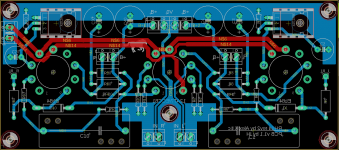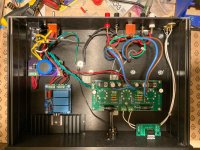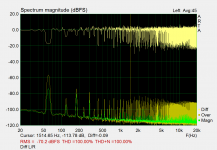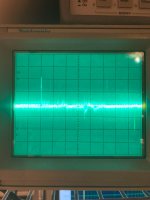Hi!
I'm finalizing a build of the RH84 SE EL84/12AT7 amp and dealing with some noise issues.
The symptom right now is sort of a buzz that is audible on the left channel only.
This is audible with Sennheiser HD660s headphones which are fairly sensitive at 104dB.
It goes away if the volume pot is at min or max position.
I've read this could be noise coupled to the input wires... I moved a bunch of wire around and it didn't make any difference. The input wires are shielded coaxial.
B+ is regulated with Maida regulator so shouldn't be a source of noise.
I experimented with a regulated DC heater supply and that did eliminate this specific noise, but seemed to introduce a different, barely audible hash.
I ordered parts to try and elevate the heater center tap to about 60V, but is there anything else I can try in the meanwhile?
I have an analog oscilloscope and PC-based spectrum analyzer so can do a few tests and post back if it helps diagnosis.
P.S. The PCB is of my own design, it is the first PCB I've made and so may not be perfect. Although, given that the noise goes away with volume maxed out, I don't think that it specifically is the issue.
I'm finalizing a build of the RH84 SE EL84/12AT7 amp and dealing with some noise issues.
The symptom right now is sort of a buzz that is audible on the left channel only.
This is audible with Sennheiser HD660s headphones which are fairly sensitive at 104dB.
It goes away if the volume pot is at min or max position.
I've read this could be noise coupled to the input wires... I moved a bunch of wire around and it didn't make any difference. The input wires are shielded coaxial.
B+ is regulated with Maida regulator so shouldn't be a source of noise.
I experimented with a regulated DC heater supply and that did eliminate this specific noise, but seemed to introduce a different, barely audible hash.
I ordered parts to try and elevate the heater center tap to about 60V, but is there anything else I can try in the meanwhile?
I have an analog oscilloscope and PC-based spectrum analyzer so can do a few tests and post back if it helps diagnosis.
P.S. The PCB is of my own design, it is the first PCB I've made and so may not be perfect. Although, given that the noise goes away with volume maxed out, I don't think that it specifically is the issue.
Attachments
You run the heater trace too close to the left channel input on the PCB.
What's the values of your volume pot and R1/R10?
Also the audio record of the buzz might help.
What's the values of your volume pot and R1/R10?
Also the audio record of the buzz might help.
TG, thanks for the input.
- the trace is fairly close but because there is no noise with volume pot maxed out, I don't think this is the issue. Also, that is the right channel and not left channel.
- volume pot is 50k.
- R1/R10 is 1M
Forgot to mention the schematic of PCB is identical to the RH84 site, here:
RH Amplifiers: RH84 amplifier - revision 2
- the trace is fairly close but because there is no noise with volume pot maxed out, I don't think this is the issue. Also, that is the right channel and not left channel.
- volume pot is 50k.
- R1/R10 is 1M
Forgot to mention the schematic of PCB is identical to the RH84 site, here:
RH Amplifiers: RH84 amplifier - revision 2
R1/R10 are shunted by the outut impedance of the pot, and that impedance is highest in the middle pot position.
1M is ridiculously high value for the R1/R10, it'll pick up all sorts of EMI (apart from own thermal noise). Try to reduce it to ~100-150k.
1M is ridiculously high value for the R1/R10, it'll pick up all sorts of EMI (apart from own thermal noise). Try to reduce it to ~100-150k.
Thanks for the tip, I'll give it a shot.
The Tubelab SPP I've built uses the 220K. That said, it seems like 1M is a fairly typical grid leak resistor, isn't it ?
The Tubelab SPP I've built uses the 220K. That said, it seems like 1M is a fairly typical grid leak resistor, isn't it ?
Does the noise occur at full clockwise setting of the volume control, with *nothing* plugged into the input jacks?
Assuming the answer is yes, then your analysis is correct, that the noise is being injected into the high impedance of the first stage grid. This isn't necessarily into the shielded wires, and could be noise injected into the cathode or a ground issue. So the next two questions:
Do you have another input valve to swap, to eliminate an obvious source?
And two, Could you describe the grounding scheme?
And don't worry about the 1M resistor. That information is incorrect.
YOS,
Chris
Assuming the answer is yes, then your analysis is correct, that the noise is being injected into the high impedance of the first stage grid. This isn't necessarily into the shielded wires, and could be noise injected into the cathode or a ground issue. So the next two questions:
Do you have another input valve to swap, to eliminate an obvious source?
And two, Could you describe the grounding scheme?
And don't worry about the 1M resistor. That information is incorrect.
YOS,
Chris
- Yes, there is noise at full volume with nothing plugged in. Silent at full volume with the source connected to the input.
- I tried 4 different valves... they aren't new (used Telefunken, Mullard, and RCA 6201, Phillips 6201). They all have the same issue which is on the left channel.
- Grounding scheme... I'll do my best to describe this clearly.
At a high-level, the PCB's are connected serially until the main amp PCB ties back to the star ground on the chassis.
Speaker/HP out (-) and heater CT tie back to the same star ground (this can be seen in the picture)
PCB grounds in detail:
- Transformer HT center-tap connected to ground plane of PCB with rectifier diodes and main filter cap.
- PCB main cap ground to regulator IN-GND
- Regulator OUT-GND to main PCB GND
- Main PCB-GND to star ground on chassis
- I tried 4 different valves... they aren't new (used Telefunken, Mullard, and RCA 6201, Phillips 6201). They all have the same issue which is on the left channel.
- Grounding scheme... I'll do my best to describe this clearly.
At a high-level, the PCB's are connected serially until the main amp PCB ties back to the star ground on the chassis.
Speaker/HP out (-) and heater CT tie back to the same star ground (this can be seen in the picture)
PCB grounds in detail:
- Transformer HT center-tap connected to ground plane of PCB with rectifier diodes and main filter cap.
- PCB main cap ground to regulator IN-GND
- Regulator OUT-GND to main PCB GND
- Main PCB-GND to star ground on chassis
Will also add that the RCA inputs are isolated from the chassis,
and the volume pot PCB shares the GND between both channels, so that is where both channels first connect.
and the volume pot PCB shares the GND between both channels, so that is where both channels first connect.
Hi, nice work on your first pcb attempt. We need to know what frequency the buzz is, 60 or 120 or whatever it is.
I have built the RH84, point-to-point, and it is dead silent on both channels. Save the a Neurochrome Maida for a linestage or DHT build.
Take a simple measurement of the noise with your phone and tell us what frequency it is.
I have built the RH84, point-to-point, and it is dead silent on both channels. Save the a Neurochrome Maida for a linestage or DHT build.
Take a simple measurement of the noise with your phone and tell us what frequency it is.
and the volume pot PCB shares the GND between both channels, so that is where both channels first connect.
Perhaps interestingly, this isn't ordinarily true. Both channels' grounds are ordinarily commoned at the source. This should be called the Star Ground Fallacy, because there's a ground loop. But that's not relevant to your issue.
Looks like you've foreseen the future and connected the coax cables to a circuit board with screw terminals. Must be second sight. You can take easy advantage of your foresight by disconnecting the cables from the board. Then you'll have divided your world of issues in half. Please post results.
YOS,
Chris
Hi, nice work on your first pcb attempt. We need to know what frequency the buzz is, 60 or 120 or whatever it is.
I have built the RH84, point-to-point, and it is dead silent on both channels. Save the a Neurochrome Maida for a linestage or DHT build.
Take a simple measurement of the noise with your phone and tell us what frequency it is.
Thanks for the feedback. I used the Maida reg because I've had hum issues in the past specifically with headphone amps. Wanted to ensure that B+ was quiet.
By the way, I hooked up the amp to Klipsch Quartet's which are supposedly 97dB sensitivity and the noise is barely heard with ears right up on the driver.
I'm fairly certain this wouldn't have been an issue with most speakers.
Looks like you've foreseen the future and connected the coax cables to a circuit board with screw terminals. Must be second sight.
This board is a prototype to get everything tested. For the final build, I may solder directly to the pads.
I was able to run a few additional tests.
1) Noise stays on same channel when swapping the input wires, which would lead to the issue not being the pot
2) That said, shorting the input on the problematic side (instead of the pot) eliminates the noise.
3) The noise is visible in this scope picture. There are 4 spikes in the frame, one very 2.5 divs. V/div is 2mV and SEC/div is .5ms.
That said, the picture may not be very useful because I think the CAL knob may have not been correctly set.
4) The sprectrum analyzer picture is an overlay of both channels, with the top plot being the diff. Clearly once channel is much noiser than the other.
Lastly, I put an L-pad of about 12dB on the HP output it was dead silent and still have more than enough volume through a 2/3rds of the pot, so that may be what I'll end up doing... I still would really want to solve this in case I ever use more sensitive speakers.
Attachments
Very cool. Now you know where the issue is *not*, and that's golden knowledge. It's *not* anything about wiring or ground loops, or any other "external" source of trouble. So it's time to look into the "internal" wiring of the PCB. Good job troubleshooting and analysis.
YOS,
Chris
YOS,
Chris
Very good work, and a very good endeavor.
When I build an amp I use a 98db (1w/1m) vintage 12” Zenith for testing, and I also have a HP harness that I connect to the speaker outputs and listen. I have tried my RH84 as a headphone amp and it is dead quit. Power supply wise, I use the very inefficient Type 80 globe rectifier. But, Alex’ local, plate to plate feedback cancels a lot of injection noise.
Like I said, good work and let us know what you find. There is a forum member here who did the RH84 as a pcb. When I have time next week I will try to get him look at yours.
Cheers,
Greg
When I build an amp I use a 98db (1w/1m) vintage 12” Zenith for testing, and I also have a HP harness that I connect to the speaker outputs and listen. I have tried my RH84 as a headphone amp and it is dead quit. Power supply wise, I use the very inefficient Type 80 globe rectifier. But, Alex’ local, plate to plate feedback cancels a lot of injection noise.
Like I said, good work and let us know what you find. There is a forum member here who did the RH84 as a pcb. When I have time next week I will try to get him look at yours.
Cheers,
Greg
Here’s a simple thing you can try: run your heater wires on the outside of the board the way he does and disconnect the vias in the board.
Thanks for the additional tips ggetzoff.
I connected an iPhone (old one, with 3.5mm output) directly to the PCB terminals and there is no noise.... output is nice and quiet.
This also aligns with no noise when I shorted the PCB inputs...
But the thing that confuses me then is that when I swapped the pot leads, the noise didn't follow.
I'll also try connecting another board I have to see if there is any difference.
I connected an iPhone (old one, with 3.5mm output) directly to the PCB terminals and there is no noise.... output is nice and quiet.
This also aligns with no noise when I shorted the PCB inputs...
But the thing that confuses me then is that when I swapped the pot leads, the noise didn't follow.
I'll also try connecting another board I have to see if there is any difference.
As Chris says - Do you get the buzz if the input connectors on the amp board are not wired up? If you have a bench supply try the heaters off that to experiment.
Last edited:
Yes there is a buzz when no inputs are connected, but I don't know if that is the same symptom. I think the amp can oscillate if there are no inputs.
Will also try DC heaters again when I get a moment
Will also try DC heaters again when I get a moment
If the input resistor is 1meg that's rather high unless its a guitar input. You will get some buzz of the heaters especially if they share the transformer with the HT. If you are using a pot instead suggest you make it 100K log.
Yes there is a buzz when no inputs are connected, but I don't know if that is the same symptom. I think the amp can oscillate if there are no inputs.
Will also try DC heaters again when I get a moment
yes, it will oscillate if the input is open.
- Home
- Amplifiers
- Tubes / Valves
- Troubleshoot noise in tube-amp, volume pot dependent



